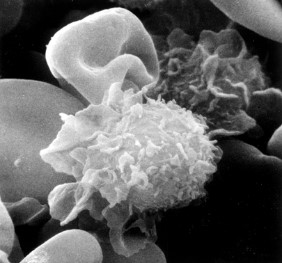Learn
Phagocytic WBCs
Here are the highlights of the phagocytic WBCs:
Neutrophils

- Functions: First cells to reach an area where a breach in the body has been made as in a cut. They kill germs by phagocytosis or “cell-eating” and release enzymes to digest it. They attach to the walls of the blood vessels, blocking the passageway of pathogens that try to gain access to the blood.
- Most abundant WBC in the circulation.
- Main target: Bacteria and Fungi
Monocytes

- Functions: Phagocytosis (cell-eating) of any dead body cell and bacteria. Digests large foreign particles in a wound.
- Respond to the site of infection.
- Main Target: bacteria, fungi, dead body cells, cancer cells.

- Functions: Work by releasing toxins from their granules to kill pathogens. Attach to and help immobilize invaders.
- High eosinophil counts are associated with allergic reactions.
- Main target: Parasites, such as intestinal worms, and allergic reactions.

- Functions: Have the ability to secrete anticoagulants (keeps blood from clotting) and antibodies that have function against hypersensitivity reactions in the bloodstream. Help to bring more immune cells to infection site by releasing histamine, which dilates the vessels.
- May have a role in the ongoing inflammation seen in chronic allergy-related conditions, such as allergic asthma.
- Granules inside basophils contain high concentrations of histamine important mediator of allergic reactions promoting blood flow and heparin an anti-blood clotting chemical that are released causing an inflammatory response.
- Main Target: Parasites and Allergic Reactions
![]() Check your understanding:
Check your understanding:
-If you contracted Giardia (a parasite that causes diarrhea) while traveling, which of the phagocytic WBCs would you expect to increase in number to attack this parasite?
-Which of the phagocytic WBCs engulfs bacteria and fungi entering your body and digests them through the release of chemicals?
-You are stung by a bee and develop an inflammatory reaction around the site of the bee sting. Besides the local mast cells, which of the WBCs would be playing a role in this inflammatory response due to its release of histamine and heparin?
-Both heparin and histamine are chemicals released by basophils as part of the inflammatory reaction. What is the difference between the effects of each chemical?
